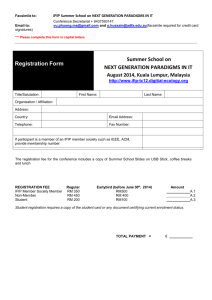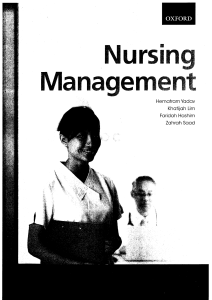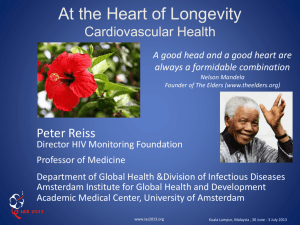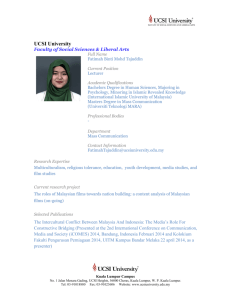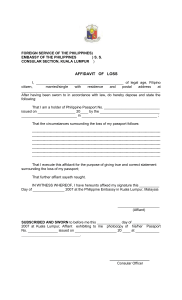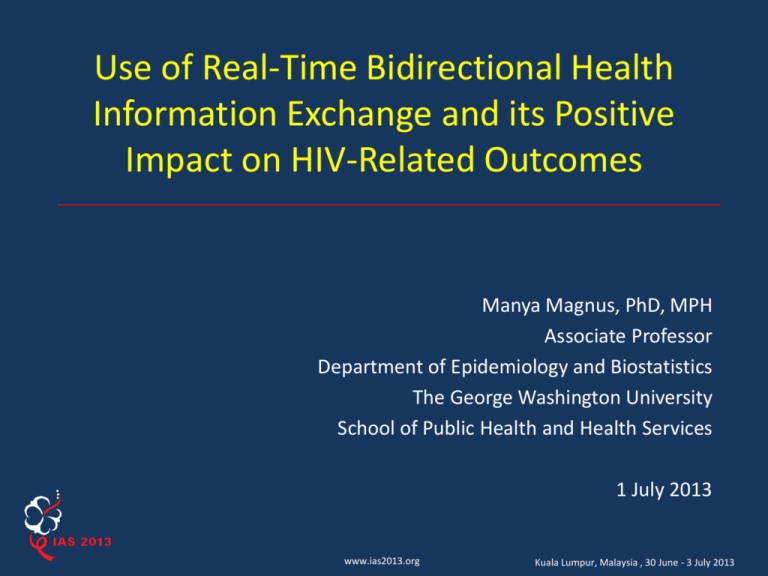
Use of Real-Time Bidirectional Health
Information Exchange and its Positive
Impact on HIV-Related Outcomes
Manya Magnus, PhD, MPH
Associate Professor
Department of Epidemiology and Biostatistics
The George Washington University
School of Public Health and Health Services
1 July 2013
www.ias2013.org
Kuala Lumpur, Malaysia , 30 June - 3 July 2013
Acknowledgements (1)
• This study was funded in part by a grant from the
Health Resources and Services Administration, Special
Projects of National Significance within the HIV/AIDS
Bureau, HRSA Grant #H97HA08476
• The content of this presentation does not necessarily
reflect the views or policies of DHHS/HRSA and
responsibility for the content rests solely with the
authors
• The authors have no conflicts of interest to report
© Copyright 2009
Board of Supervisors of Louisiana State University and
Agricultural and Mechanical College, through its LSU Health Sciences Center
ALL RIGHTS RESERVED
www.ias2013.org
Kuala Lumpur, Malaysia , 30 June - 3 July 2013
Acknowledgements (2)
• Jane Herwehe, Michael Kaiser, Luis Smith, Amir Abrams,
Keith Verret, Wayne Wilbright, Ke Xiao – LSU HCSD
• Elizabeth Shepard, DeAnn Gruber, Joseph Foxhood, Amy
Zapata, George Stephens, Beth Scalco, Debbie Wendell–
OPH SHP
• Charles Daspit – LA DHH
• Roma Oliveri, Louis Trachtman, Charles DeGraw - OPH TB
Control
• Eric Baumgartner - LPHI
• Lisa Longfellow, formerly of OPH
• Michelle Murtaza-Rossini, formerly of LSU
• Susan Bergson and Clayton Williams, formerly of LPHI
www.ias2013.org
Kuala Lumpur, Malaysia , 30 June - 3 July 2013
Acknowledgements (3)
•
•
•
•
•
•
•
•
•
•
•
•
Patient community
LSU/TU clinicians
ILH Infection Control
Delta Region AETC
LSU SPH Medical Informatics & Telemedicine
LIS Core Group
OPH nurses
OPH epidemiologists
OPH Disease Intervention Specialists
OPH Medical Directors
HCSD Programming Support
LaPHIE workgroups membership
www.ias2013.org
Kuala Lumpur, Malaysia , 30 June - 3 July 2013
Background (1)
Epidemiology of HIV in Louisiana, U.S.A
www.cdc.gov
www.ias2013.org
Kuala Lumpur, Malaysia , 30 June - 3 July 2013
Background (2)
Epidemiology of HIV in Louisiana, U.S.A
• In 2011
– Louisiana ranked 3rd in US for estimated HIV case
rates (30.2 per 100,000)
– The Baton Rouge metropolitan area ranked 1st
(29.4 per 100,000) and the New Orleans
metropolitan area ranked 4th (25.3 per 100,000) in
estimated AIDS case rates among the large
metropolitan areas in the US
– 32% of all persons living with HIV infection in
Louisiana were not in care
2011 STD/HIV Program Report
State of Louisiana, Department of Health and Hospitals, Office of Public Health
www.ias2013.org
Kuala Lumpur, Malaysia , 30 June - 3 July 2013
Background (3)
Missed opportunities for HIV care
• Louisiana State University (LSU) Health Care Services
Division (HCSD) is an integrated delivery network
(IDN)
–
–
–
–
–
7 safety-net hospitals
Numerous ambulatory clinics
70,000 inpatient admissions per year
1.4 million outpatient encounters per year
Provides HIV treatment to 60–75% of HIV-infected persons
in Louisiana
• 2007 data match identified 1,100 people with missed
opportunities for HIV treatment and care
www.ias2013.org
Kuala Lumpur, Malaysia , 30 June - 3 July 2013
Health information exchange (HIE)
as a critical tool
• “…electronic movement of health-related information among
organizations according to nationally recognized
standards. The goal of HIE is to facilitate access to and
retrieval of clinical data to provide safer, timelier, efficient,
effective, equitable, patient-centered care” 1
• “…exchanging patient health information among health care
providers regardless of the source of the information. HIE
enhances patient care by providing timely access to more
accurate and complete information” 2
1
http://www.hrsa.gov/healthit/toolbox/RuralHealthITtoolbox/Collaboration/whatishie.html
Information Exchange http://www.healthit.gov/sites/default/files/hie_uc_workgroup_final_report.pdf
2Strengthening Health
www.ias2013.org
Kuala Lumpur, Malaysia , 30 June - 3 July 2013
Development of Louisiana Public Health
Information Exchange (LaPHIE)
• LaPHIE
– “No wrong door” approach at 8 hospitals and nearly 100 clinics
– Real time identification of people out of HIV specialty care
• A programmatic, multi-organizational effort to improve health
• Advanced real-time health information exchange with EMRintegrated alerting system
• Capitalizes on opportunities to improve health outcomes
– Opportunity to provide clinical services at time of alert
– Allows re-engagement of patient in HIV specialty care and support
services
• Designed to overcome system challenges
• Building system foundation
– Qualitative work, legal analysis, community engagement, multiple
organizational collaborations
www.ias2013.org
Kuala Lumpur, Malaysia , 30 June - 3 July 2013
System architecture
Physician follows onscreen steps to re-engage
patient into care and
provide HIV treatment, as
appropriate
Patient
comes to
clinic,
hospital, or
ED for nonHIV service
Real time communication with
surveillance system alerts
physician that patient needs
attention for HIV/AIDS
HIV clinic
www.ias2013.org
Kuala Lumpur, Malaysia , 30 June - 3 July 2013
OPH Firewall
Point-to-Point
Dedicated
T1
LSU Firewall
Registration
ADT
HIV/STD/TB
Out of Care
Patients
PPR / PRR
LaPHIE Server
Interface Engine
Clinical
Info. System
www.ias2013.org
Kuala Lumpur, Malaysia , 30 June - 3 July 2013
LaPHIE evaluation methods
Research question
Methods
Identification, engagement,
retention, timeliness
Cohort design
Patient experience
-Survey (quantitative)
-Comparison of patients in care, at risk
of being out of care, linked into care,
proxies for high-risk patients out of care
Provider experience
-Survey (quantitative)
-Qualitative interviews
-Utilization data
Feasibility, system impact, quality
of care indicators, utilization
-Qualitative interviews
-Chronology and organizational
assessment
www.ias2013.org
Kuala Lumpur, Malaysia , 30 June - 3 July 2013
Impact (1)
Between 2/1/09 and 7/31/11
• 549 real-time alerts shown to 223 clinicians
– 58% physicians, 42% nurses or physician assistants
• 74% acted upon by clinician*
• Common actions taken at point of service**
– 43%
– 32%
– 15%
– 8%
Referral to HIV care & treatment
Discussing importance of treatment
Assessing patient’s disease stage
In care elsewhere or refused care
*Of those not acted upon, 56% previously were addressed
**Could be more than one
www.ias2013.org
Kuala Lumpur, Malaysia , 30 June - 3 July 2013
Impact (2)
Between 2/1/09 and 7/31/11
• Identified 419 unduplicated HIV-infected
persons out of care > 1 year
– 24% no care since diagnosis
– 76% at least one prior visit
• 55% of whom had been out of care ≥18 months
• Median time since last visit: 19.4 months [IQR 15.0–
32.5, range 0.20–108.7 months]
• 32% had not been seen in LSU system for any
HIV-related test or care
– Would have been missed in the absence of LaPHIE
Note: Cumulatively between 2/1/09 and 12/31/12:
854 unduplicated, out of care > 1 year, HIV infected persons identified
www.ias2013.org
Kuala Lumpur, Malaysia , 30 June - 3 July 2013
Impact (3)
Characteristics of 419 individuals identified
between 2/1/09 and 7/31/11
•
•
•
•
46% <35 years of age
68% black/African American
63% male
Mode of HIV acquisition
–
–
–
–
49% no identified risk or unknown
22% heterosexual
14% MSM
4% IDU
• 42% CD4 < 200 cells/mm3
– Median CD4 242 [IQR 75–407]
• 62% HIV RNA PCR > 10,000 copies/mL
– HIV RNA PCR copies/mL 31,333 [2,762–147,327]
www.ias2013.org
Kuala Lumpur, Malaysia , 30 June - 3 July 2013
Impact (4)
Retention
• Of the 344 people identified in the first 18 months of
the program and followed at least 6 months
– 85% had at least one viral load and/or CD4 count
• Of those who had been out of care > 18 months
before being identified
– 82% returned for at least one visit
• Once identified by LaPHIE, patients were successfully
retained in care
– Majority of patients had at least one visit every 6 months
– Declining viral loads in aggregate over follow up
– Success in linking and retaining hardest to reach patients
www.ias2013.org
Kuala Lumpur, Malaysia , 30 June - 3 July 2013
Impact (5)
Retention
www.ias2013.org
Kuala Lumpur, Malaysia , 30 June - 3 July 2013
Impact (6)
Retention
www.ias2013.org
Kuala Lumpur, Malaysia , 30 June - 3 July 2013
Case scenario
Before and after LaPHIE
Before
After
Repeat ER visits but no HIV care or treatment
Now linked into care
Newly released from prison; post Hurricane
Katrina evacuation; did not know where to go
Linked by LaPHIE now in care
“There will always be people falling through
cracks” “Some people have given up”
Opportunities to re-engage at least annually
Denial, need to “come to terms with diagnosis”
Immediate linkage: “It was very helpful that I was
able to come in for my first visit on the next day
after I called to make the appointment”
Following Hurricane Katrina unaware that clinic
had re-opened
Appointment next day and given meds right then
Structural barriers: no transportation, long work
schedule, lost children’s social security cards, etc.
LaPHIE alert helped link to services and then to
care
“Was given hope, I saw a graph that help me
understand that my CD4 count could increase
with treatment”
Frightened, denial, did not want to deal with
diagnosis
Death of wife; slipped out of care due to
depression
Has come back for care as he has faced some of
the struggles and has come out of it seeking care.
He has set goals, met new people and is on path
to excel in life and with HIV care
www.ias2013.org
Kuala Lumpur, Malaysia , 30 June - 3 July 2013
How can HIE support HIV-related outcomes? (1)
• An “EMR” is not enough
• HIV information exchange can promote
– HIV prevention on the population level
– Individual level health improvements
• Need systems that
–
–
–
–
–
–
Identify out of care persons with HIV
Link them into care and keeps them in care
Are not prohibitively expensive
Overcome distance and other characteristics
Acceptable to providers, patients, and communities
Confidential
www.ias2013.org
Kuala Lumpur, Malaysia , 30 June - 3 July 2013
How can HIE support HIV-related outcomes? (2)
• Using HIE with population-based approaches,
Louisiana was able to
–
–
–
–
Identify out of care HIV-infected people
Facilitate engagement and retention in care
Engage them in HIV specialty care over follow up
Offer clinical services to improve individual- and
population-level health
• Acceptable to patients and providers
• Well-developed, stakeholder involved process
promotes success
• National interest and enthusiasm for HIE
www.ias2013.org
Kuala Lumpur, Malaysia , 30 June - 3 July 2013
Questions
For more information please contact
Manya Magnus
202 994 3024
manyadm@gwu.edu
© Copyright 2009
Board of Supervisors of Louisiana State University and
Agricultural and Mechanical College, through its LSU Health Sciences Center
ALL RIGHTS RESERVED
www.ias2013.org
Kuala Lumpur, Malaysia , 30 June - 3 July 2013

